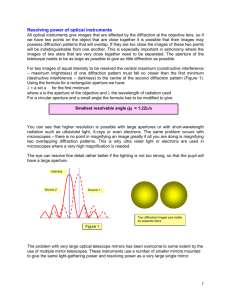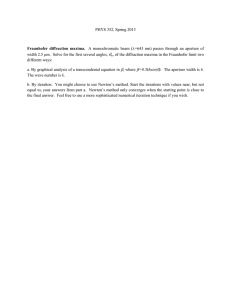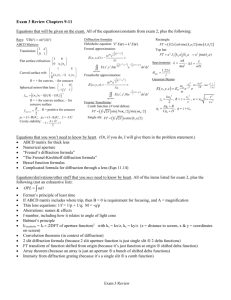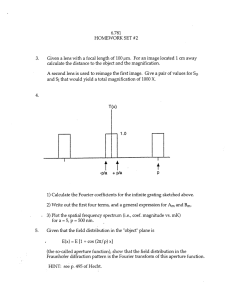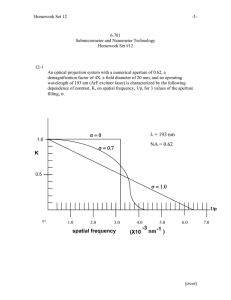471/Lectures/notes/lecture 30 Diffraction b.pptx
advertisement
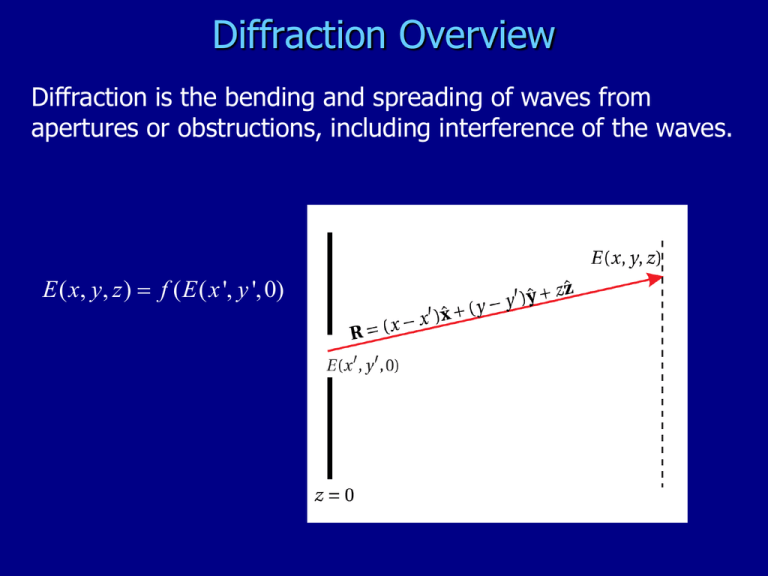
Diffraction Overview Diffraction is the bending and spreading of waves from apertures or obstructions, including interference of the waves. E ( x, y, z ) f ( E ( x ', y ', 0) Diffraction for increasing screen distance Looks like the aperture with fringes! (Fresnel) Aperture 200x100 l/2p z screen 20 l/2p z screen 100 l/2p “Far field” looks like |FT|2 of aperture! (Fraunhoffer diffraction) z screen 500 l/2p z screen 2500 l/2p Diffraction Calculations How could we solve E ( x, y , z ) with no approximations? 2 E 2 E o o 2 0 t plus boundary conditions. …but there are easier approximations! f ( E ( x ', y ', 0) http://www.falstad.com/ripple/ (download, extract and run the .jar file with Java) Huygens’ principle 1678 Every point on a wavefront acts like a “forward spherical” scalar source. Conceptual tool: gave Snell’s law, finds diffraction maxes, mins Fresnel’s update --- make it formal: ei( kr t) 1 cos ( r , ˆz 2 r Obeys a scalar wave equation 2E E o o 2 0 t 2 Hard to solve vs 2 E ( r k 2 E ( r 0 Helmholtz equation ei( kr t ) r Works when: essentially single frequency E doesn’t change significantly over a distance of l Forget about polarization (if we further required small l, we’d get the Eikenol equation…then no diffraction) Fresnel-Kirchoff diffraction formula Fresnel’s diffraction model: add these Huygen waves from the openings…it works pretty well! ei( kr ) 1 cos ( r , ˆz 2 dx ' dy ' E ( x, y, z C E ( x, y, 0 R( x ', y ', z ') aperture Kirchhoff found the factor: Put on firm math foundation with Green’s theorem and Helmholtz equation i meaning? C i l Fresnel approximation i ei( kr t) 1 cos ( r , ˆz 2 dx ' dy ' E ( x, y, z E ( x, y, 0 l aperture r Becomes: (know how to do this step with small angle/binomial approx’s) E ( x, y, z ikz ie e i ( k 2 2 x y 2z lz E ( x, y, 0 e i ( k x 2 y 2 2z e i k ( xx yy z dxdy aperture restrictions: a (size of aperture) > l [scalar wave approx] z of screen > a (but if get far enough, becomes simpler Fraunhofer) x,y of screen <<z, so angles on screen are small Diffraction for increasing z, using Fresnel equations Aperture 200x100 l/2p z screen 20 l/2p z screen 100 l/2p Looks like the aperture with fringes! (Fresnel diffraction) “Far field” looks like |FT|2 of aperture! (Fraunhoffer diffraction) z screen 500 l/2p z screen 2500 l/2p Fresnel diffraction for slit, increasing z Babinet’s principle for complementary patterns The diffraction features caused by an aperture are also present in those of a “block”. Complimentarity principle The diffraction pattern for an aperture is similar (but not identical) to the pattern for a “block” of the same shape Eblock Eincident Eslit Circular hole diffraction D = 1 to 4 mm, screen 1 meter away, HeNe light Fresnel diffr.: Center alternates bright/dark Complimentarity principle Poisson’s spot in shadow of ball bearing Center is always bright Converging thin lens/mirror imaging review Converging thin lens/mirror imaging review Diverging thin lens/mirror imaging review "The picture shows a spherical mirror, resting on [my] left hand… Such a globe reflection collects almost one's whole surroundings in one diskshaped image. the whole room, four walls, the floor, and the ceiling, everything, albeit distorted, is compressed into that one small circle. Your own head, or more exactly the point between your eyes, is the absolute center. No matter how you turn or twist yourself, you can't get out of that central point. You are immovably the focus, the unshakable core, of your world." - M. C. Escher Diverging thin lens/mirror imaging review
